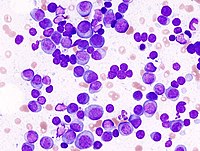
Photo from wikipedia
Increasing production and application of silver nanoparticles (Ag NPs) have raised concerns on their possible adverse effects on human health. However, a comprehensive understanding of their effects on biological systems,… Click to show full abstract
Increasing production and application of silver nanoparticles (Ag NPs) have raised concerns on their possible adverse effects on human health. However, a comprehensive understanding of their effects on biological systems, especially immunomodulatory responses involving various immune cell types and biomolecules (e.g., cytokines and chemokines), is still incomplete. In this study, a single-cell-based, high-dimensional mass cytometry approach is used to investigate the immunomodulatory responses of Ag NPs using human peripheral blood mononuclear cells (hPBMCs) exposed to poly-vinyl-pyrrolidone (PVP)-coated Ag NPs of different core sizes (i.e., 10-, 20-, and 40-nm). Although there were no severe cytotoxic effects observed, PVPAg10 and PVPAg20 were excessively found in monocytes and dendritic cells, while PVPAg40 displayed more affinity with B cells and natural killer cells, thereby triggering the release of proinflammatory cytokines such as IL-2, IL-17A, IL-17F, MIP1β, TNFα, and IFNγ. Our findings indicate that under the exposure conditions tested in this study, Ag NPs only triggered the inflammatory responses in a size-dependent manner rather than induce cytotoxicity in hPBMCs. Our study provides an appropriate ex vivo model to better understand the human immune responses against Ag NP at a single-cell level, which can contribute to the development of targeted drug delivery, vaccine developments, and cancer radiotherapy treatments.
Journal Title: Pharmaceutics
Year Published: 2022
Link to full text (if available)
Share on Social Media: Sign Up to like & get
recommendations!